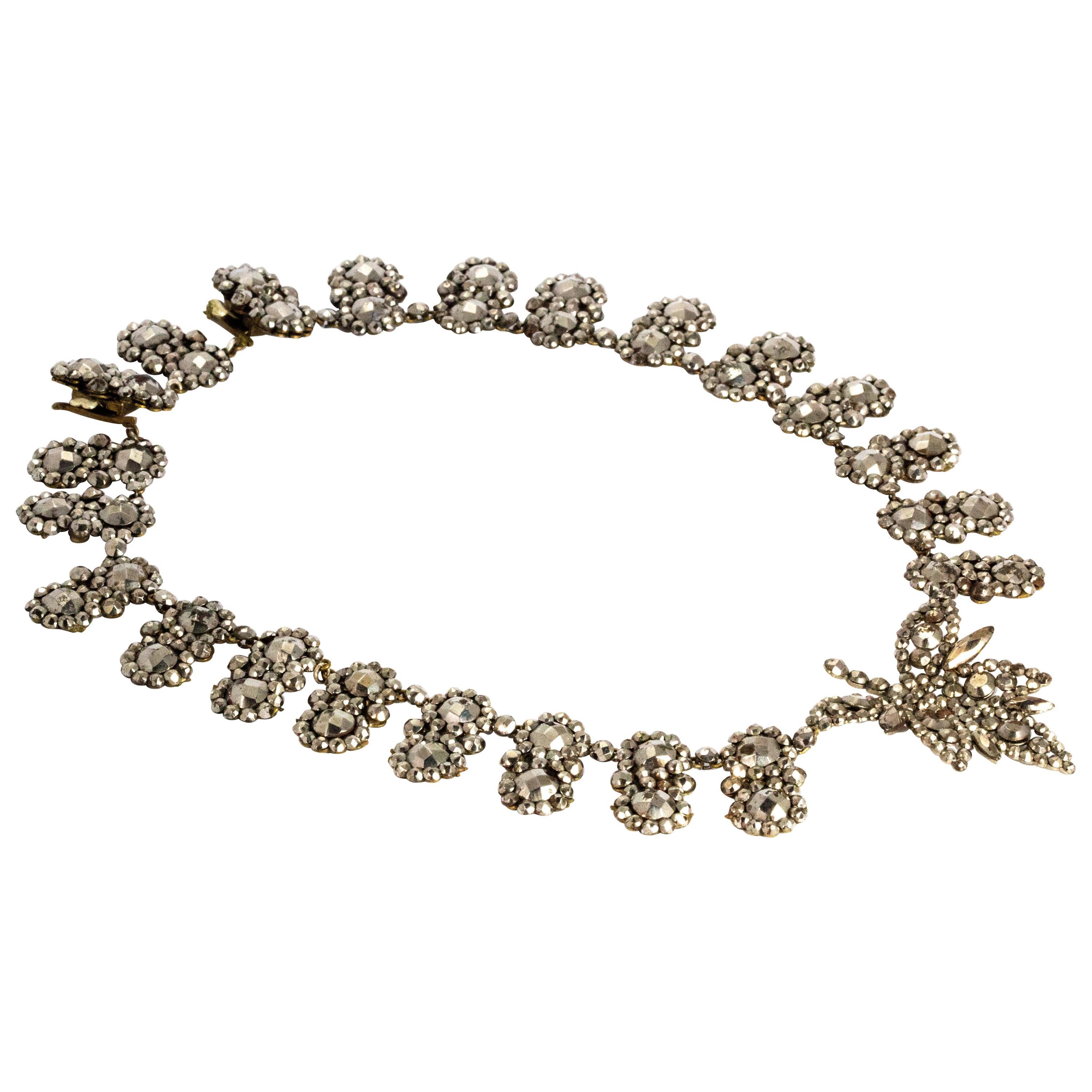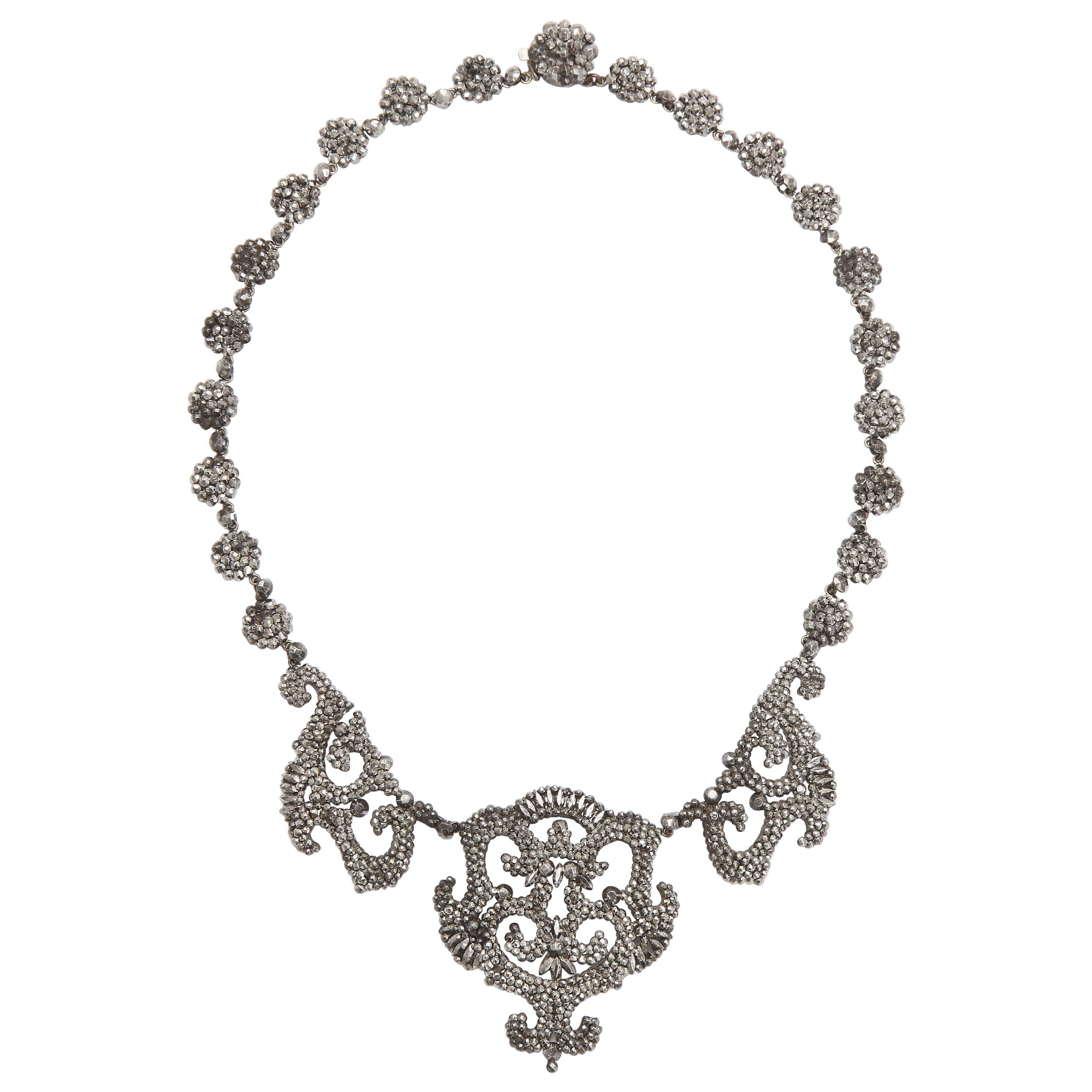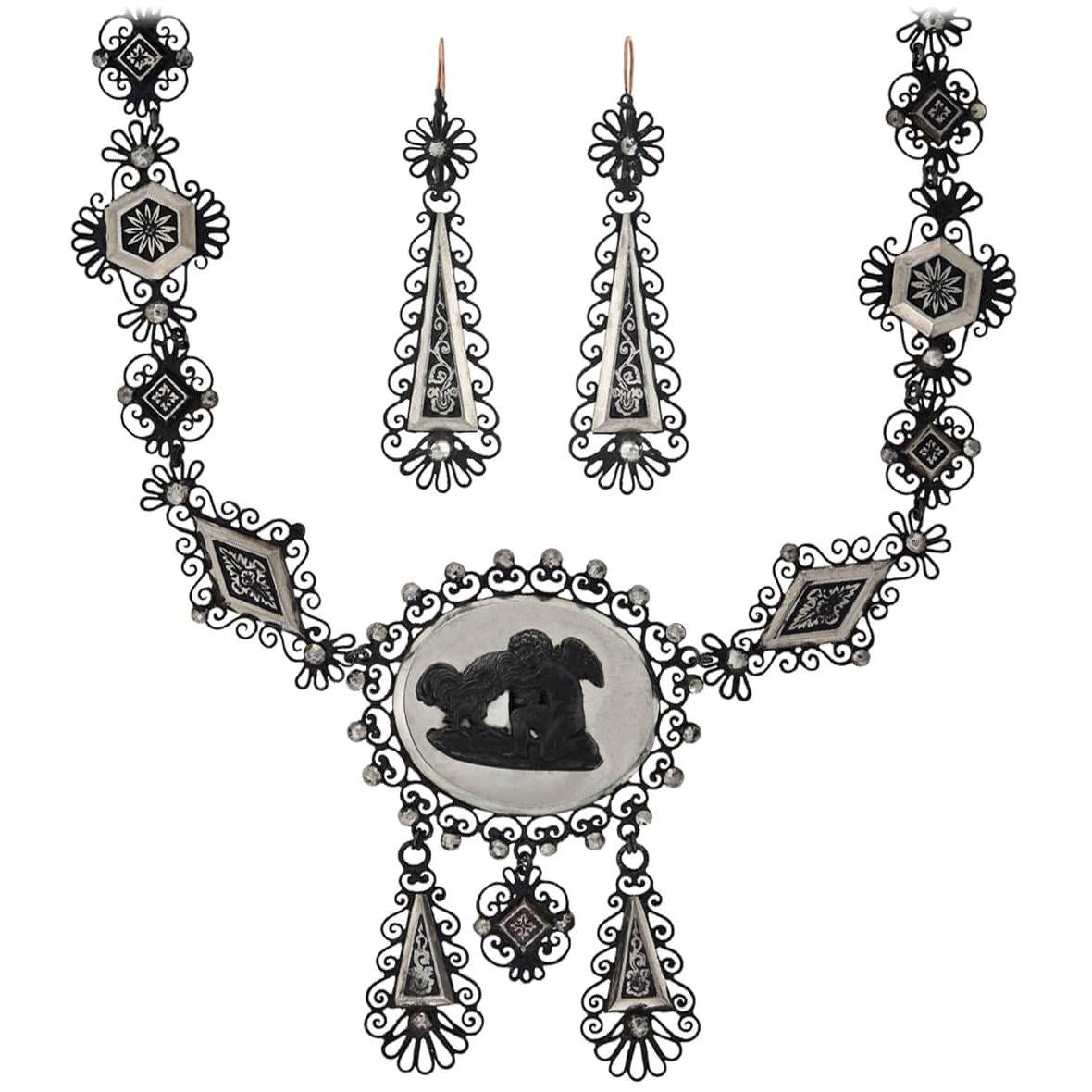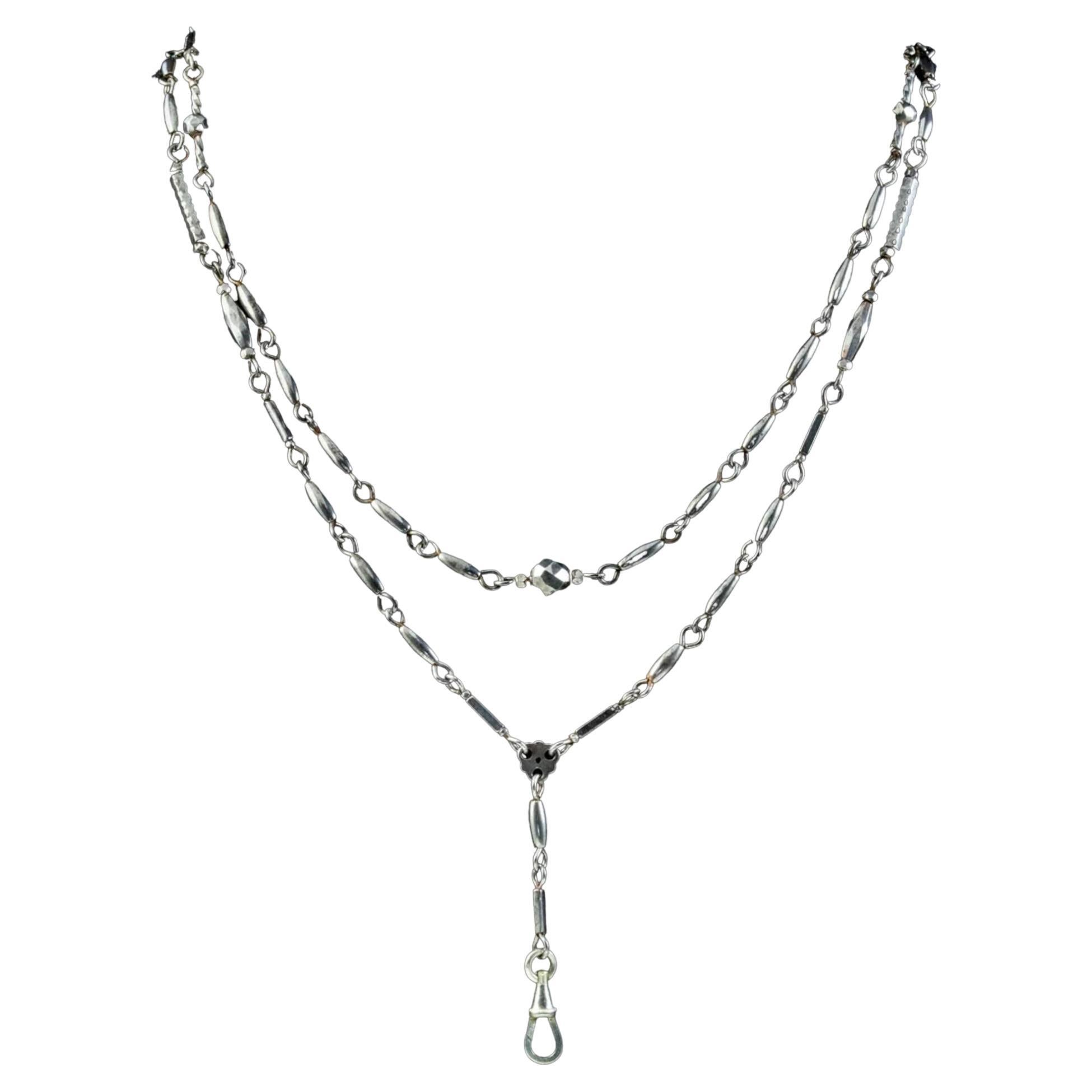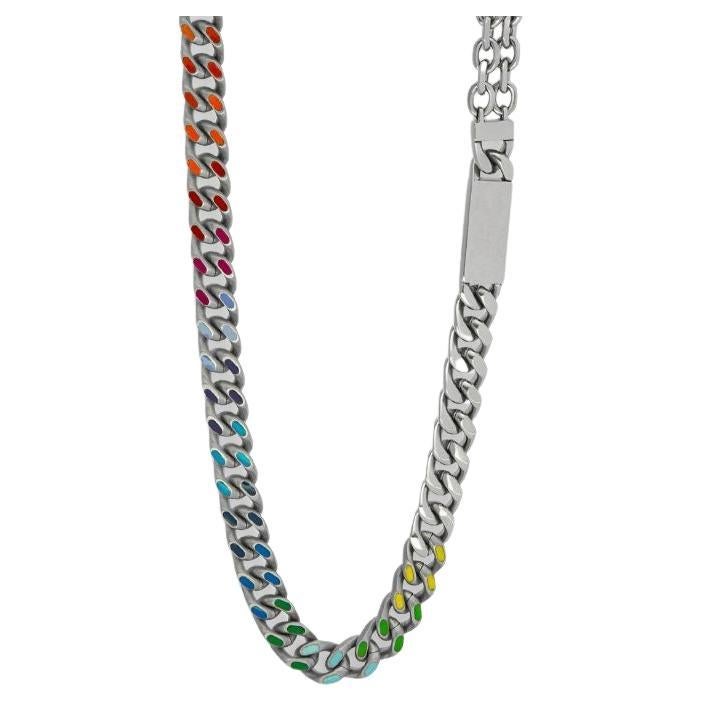Items Similar to Georgian Cut Steel Necklace
Want more images or videos?
Request additional images or videos from the seller
1 of 6
Georgian Cut Steel Necklace
About the Item
Absolutely superb example of Georgian cut steel. The way it sparkles and catches the light is just beautiful. This necklace sits perfectly flat and is a great length with the drop detail.
Length: 15 1/2inches
- Metal:
- Style:
- Place of Origin:
- Period:1710-1719
- Date of Manufacture:circa 1714
- Condition:Wear consistent with age and use.
- Seller Location:Chipping Campden, GB
- Reference Number:1stDibs: LU118136240502
About the Seller
4.8
Platinum Seller
These expertly vetted sellers are 1stDibs' most experienced sellers and are rated highest by our customers.
Established in 2004
1stDibs seller since 2018
2,373 sales on 1stDibs
Typical response time: 3 hours
- ShippingRetrieving quote...Ships From: Chipping Campden, United Kingdom
- Return PolicyA return for this item may be initiated within 7 days of delivery.
More From This SellerView All
- Mid-19th Century Cut Steel NecklaceLocated in Chipping Campden, GBAny fan of cut steel would be unbelievably happy with this piece, it is in lovely condition and the reflective links are mesmerising! The detailed centre panel is a decorative leaf w...Category
Antique Mid-19th Century British Victorian More Necklaces
MaterialsCut Steel
- Edwardian Silver Paste Georgian Style NecklaceLocated in Chipping Campden, GBStunning Georgian inspired silver paste necklace. The sparkle on this piece is just beautiful and sits perfectly. Length: 16 1/2inchesCategory
Antique Early 1900s Unknown Georgian More Necklaces
MaterialsSilver
- Georgian Paste and Gold Filled NecklaceLocated in Chipping Campden, GBThis necklace is absolutely gorgeous! The paste have a sunny orange glow to them and th necklace is gold filled. The settings are so ornate and have delicate detail. Length: 42cm S...Category
Antique 1830s British Georgian More Necklaces
MaterialsGold-filled
- Georgian Boxed Flat Cut Garnet Necklace and Earrings Suite in GoldLocated in Chipping Campden, GBGeorgian Boxed Flat Cut Garnet Necklace and Earrings Suite in Gold Exceptional glowing garnet jewellery set, elegant and beautiful The item come...Category
Antique 19th Century European Georgian Drop Necklaces
MaterialsGarnet, Gold
- Edwardian Garnet 15 Carat NecklaceLocated in Chipping Campden, GBIn between every smooth gold loop in this chain sits a bright sparkling garnet. The necklace sits beautifully flat against the neck and also, as a little added bonus, has a tiny hook...Category
Antique Early 1900s Unknown Edwardian More Necklaces
MaterialsGarnet, 15k Gold
- Victorian Silver Fancy Collar NecklaceLocated in Chipping Campden, GBThis necklace could be worn two ways, the more decorative side or the simple side. Coins on this collar are engraved on one side and are plain and glossy on the other side. The neck...Category
Antique 1850s British Victorian Link Necklaces
MaterialsSilver
You May Also Like
- Antique Georgian1820s Early Cut Steel NecklaceLocated in Stamford, CTA crowning glory of design, this cut steel necklace shimmers like diamonds, in available light as it did originally in the early 1800's. Serves dressy occasions or denim shirts and b...Category
Antique Early 18th Century British George IV Link Necklaces
MaterialsCut Steel
- Georgian Berlin Iron and Mirrored Cut Steel Necklace and Earring SetLocated in Narberth, PABerlin iron jewelry was produced in Germany by the Berlin Royal Foundry beginning in 1804. Previously, iron jewelry had been worn primarily during periods of mourning due to the dark color of its black lacquer finish. However, it reached a high point of popularity between 1813 and 1830. To fund the War of Liberation against Napolean, citizens were asked to donate their precious gold in exchange for iron jewelry. The Berlin iron jewelry was sometimes inscribed with a portrait of Frederick William III of Prussia, or with the words "Gold gab ich für Eisen" (meaning "I gave gold for iron") or "Für das Wohl des Vaterlands" ("For the welfare of our country/fatherland"). Almost overnight, Berlin iron jewelry became a symbol of patriotism. Its beautiful fabrication and lacy appearance gave it widespread appeal, eventually reaching popularity in numerous European countries. Authentic Berlin iron jewelry is now very rare, and well-preserved pieces have become very collectible! Cut steel jewelry originated in England in the 17th century and subsequently spread throughout Europe, eventually becoming a popular style of jewelry worn by members of high society during the Victorian era. Made of polished faceted steel studs, the pieces were cut by hand and then assembled and riveted onto a metal back. The faceted steel elements give this type of jewelry a subtle, metallic glitter that resembles cut gemstones. Motifs varied from the simple to the sublime, with multiple layers and densely packed studs. The time-consuming process and the artistry required to create cut steel jewelry made it very valuable and highly sought-after during the Victorian age, particularly to wear during the stage of "secondary mourning." Produced up until the turn of the 19th century, antique cut steel jewelry is now highly collectible. An exceptional Berlin iron and cut steel necklace and earring set from the Georgian (ca1804) era! Crafted in fine Berlin ironwork with delicate cut steel studs and mirrored steel plaques throughout, this well-preserved ensemble is an incredible work of art. The ornate necklace adorns various sized iron-backed links topped with mirrored steel plaques, each one connected together by intricate, lacy Berlin ironwork. The largest link rests at the center, and features an oval-shaped mirrored steel plaque on the front that is adorns a raised iron cameo...Category
Antique Early 1800s German Georgian Link Necklaces
MaterialsBerlin Iron, Cut Steel
- Antique Georgian Cut Steel Guard Chain, circa 1810Located in Kendal, GBAn exquisite Antique Georgian guard chain from the early 19th Century made up of long, faceted Cut Steel links and spheres. It’s complete with a newer claw clasp at the end of a lo...Category
Antique 19th Century Georgian Chain Necklaces
MaterialsCut Steel
- Antique Early 19th Century Cut-Steel NecklaceLocated in Malmö, SECut steel jewelry was at the height of fashion from the mid 1700s well into the 19th century. Originated in the 1700s. Popular from the Georgian through the Victorian eras. To make cut steel, melted horseshoe nails were formed into tiny faceted beads. Those small steel gemstone-like studs were then riveted one-by-one onto a base plate. It was an English invention that quickly travelled throughout the world. Each stud could have up to 15 facets, and in general the finer and older the piece the more facets the studs will have. Improvements in candles meant that grand events and entertaining could take place at night. As diamonds are diamonds and not available for everyone, and everyone wanted to shine, the popularity grew. Cut-steel provided a stylish and popular new jewelry material that could be enjoyed by everyone at all levels of society. It grew beyond a simple imitation to an art in its own right. The manufacturing was complex and the workmanship that was required highly skilled. These were not mass produced objects. The studs were made from decarbonated cast steel, which was case-hardened, then the studs were faceted by cutting against a pewter wheel. Next were then polished with first fine emery and a hard brush, and then by hand with a special putty. Finally they were riveted onto pierced base plates which had to be drilled and cut by hand, too. The main place of cut steel production was Birmingham, England. And there, one manufacturer stood out from all the rest: Matthew Boulton. He had been born in 1728 into the industry — his father manufactured small metal products. But the younger Boulton had a special talent for marrying the latest technology with the latest fashion. He also was continually expanding — he even founded a mint. He wined and dined with dignitaries and advocated for his steel products. Fortuitously, he became quite close with the Russian ambassador to Catherine the Great. When the ambassador toured the mint, Boulton made sure to send the Empress some of his cut-steel necklaces. In 1759, Louis XV “encouraged” the nobility to donate their gold and gemstone jewelry to help fund the Seven Years War. The popularity of cut steel in France may in part have been due to these sumptuary laws which limited who could wear precious metals and diamonds. Either you complied with the law and gave up your family jewels to be melted down for the war chest...Category
Antique Early 19th Century English Early Victorian Link Necklaces
MaterialsSteel
- Stainless Steel Catena Multi NecklaceBy TateossianLocated in Fulham business exchange, LondonStainless Steel Catena Multi Necklace This necklace features a combination of different chains with links that have been hand-painted in a rainbow effe...Category
21st Century and Contemporary British More Necklaces
MaterialsSteel, Stainless Steel
- Talismanic Amulet Necklace in Stainless SteelBy TateossianLocated in Fulham business exchange, LondonTalismanic Amulet Necklace in Stainless Steel This stainless steel rotating compass amulet has been created to guide the wearer through rough seas, wh...Category
21st Century and Contemporary British More Necklaces
MaterialsSteel, Stainless Steel
Recently Viewed
View AllMore Ways To Browse
Steel Cut Jewellery
Cut Steel Jewelry
Antique Georgian Necklace
Flat Cut Necklace
Steel Cut Necklace
Georgian Flat Cut
Antique Cut Steel Jewelry
Cut Steel Jewellery Antique
Georgian Cut Steel
Georgian Steel Jewelry
Georgian Cut Steel Jewelry
Tiffany Delivery Packaging
Harry Winston Diamond Platinum Necklace
Louis Vuitton Pearl Necklace
Straight Line Diamond Tennis Necklace
Yellow Gold Cleopatra Necklace
Ysl Luxury Brand
Carved Ivory Necklace
